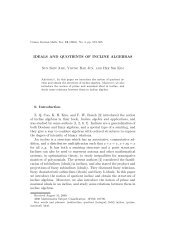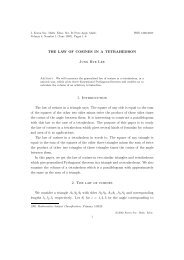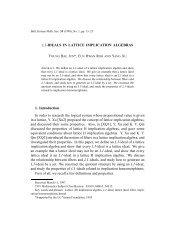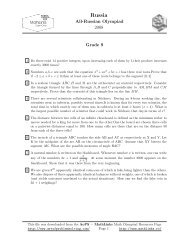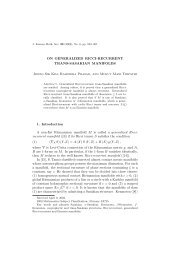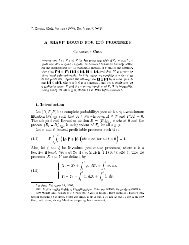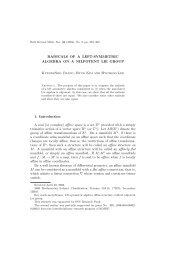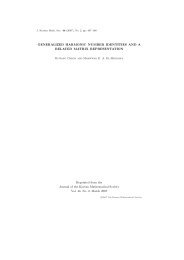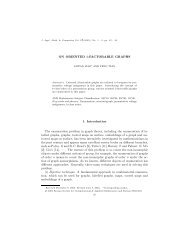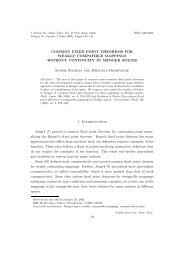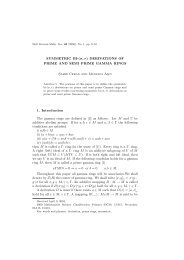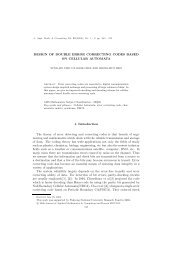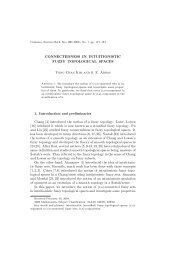The 8th Korean Mathematical Olympiad First round
The 8th Korean Mathematical Olympiad First round
The 8th Korean Mathematical Olympiad First round
You also want an ePaper? Increase the reach of your titles
YUMPU automatically turns print PDFs into web optimized ePapers that Google loves.
fternoon session (2 1 hours)25. If we select at random three points on a given circle, nd the probability that these threepoints lie on a semicircle.6. Show that any positive integer n(> 1) can be expressed by a nite sum of numbers satisfyingthe following conditions:(i) they do not have factors exept 2 or 3.(ii) any two of them are neither a factor nor a multiple each other.That is, n = P Ni=1 2 i 3 i, where i ; i (i=1;2; ;N) nonnegativeintegers and ( i , j )( i , j ) < 0 whenever i 6= j.7. Find all real valued functions f dened on real numbers except 0 such that1x f(,x)+f(1 )=x; x 6= 0:x8. Two circles O 1 ;O 2 of radii r 1 ;r 2 (r 1
[ Final <strong>round</strong> ]<strong>First</strong> day session (4 1 2hours)1. For any positive integer m, show that there exist integers a; b satisfyingjaj m; jbj m; 0
Second day session (4 1 hours)24. Let O and R be the circumcenter and the circumradius of 4ABC, respectively, and let P beany point onthe plane ABC. Let perpendiculars PA 1 ;PB 1 ;PC 1 , be dropped to the threesides BC; CA; AB. Express (4A 1B 1 C 1 )(4ABC)of 4ABC.in terms of R and d = OP, where (4ABC) is the area5. Let p be a prime number such that(i) p is the greatest common divisor of a and b;(ii) p 2 is a divisor of a. Prove that the polynomial x n+2 + ax n+1 + bx n + a + b cannot bedecomposed into the product of two polynomials with integeral coecients, whose degreesare greater tham one.6. Let m; n be positive integers with 1 n m , 1. Aboxislocked with several padlocks, allof which must be opened to open the box, and all of which have dierent keys. m people eachhave keys to some of the locks. No n people of them can open the box but any n + 1 peoplecan open the box. Find the smallest number l of locks and then the numberofkeys for whichthis is possible.4
<strong>The</strong> <strong>8th</strong> <strong>Korean</strong> Mathemtical <strong>Olympiad</strong>Solutions[<strong>First</strong> <strong>round</strong>]1. Consider a nitely many points in a plane such that, if we choose any three points A; B; Camong them, the area of 4ABC is always less than 1. Show that all of these nitely manypoints lie within the interior or on the boundary of a triangle with area less than 4.SolutionWe can take 4ABC having the maximum area among triangles whose vertices are chosen fromthe given nitely many points. <strong>The</strong>n (4ABC) 1. Here (4ABC) denotes the area of 4ABC.Let 4LMN be the trianglewhose medial triangle is4ABC. <strong>The</strong>n(4LMN)=4(4ABC) 4:We may prove that the given nitely many points lie within the interior or on the boundary of4LMN. Suppose a point P lies on the exterior of 4LMN. We may assume that a point P locatesat the opposite side of N with respect to a line ML. <strong>The</strong>n the length of a perpendicular of Pdropping to AB is larger than that of C dropping to AB.It follows that (4PAB) > (4CAB)=(4ABC) and P is never included in the given nitelymany points. This completes the proof.2. For a given positive integer m, nd all pairs (n; x; y) of positive integers such that m; n arerelatively prime and (x 2 + y 2 ) m =(xy) n , where n; x; y can be represented by functions of m.SolutionIf (n; x; y) is a solution of the given equation, then from x 2 + y 2 2xy we have (xy) n =(x 2 + y 2 ) m > (xy) n . It follows that n>m.Let p be a common prime divisor of x and y, and let p a kx; p b ky. Here p a kx means that p a jxbut p a+1 - y. <strong>The</strong>n p (a+b)n k(xy) n = (x 2 + y 2 ) m . Suppose b > a. Since p 2a kx 2 ;p 2b ky 2 , we seethat p 2a kx 2 + y 2 and p 2am k(x 2 + y 2 ) m . It follows that 2am =(a+b)n>2an and m>n. Thisis a contradiction. Similarly, a > b gives a contradiction. It concludes that a = b and x = y.Now we have x 2n = (2x 2 ) m = 2 m x 2n and x 2(n,m) = 2 m . Thus, x = 2 t for some integer t. From5
2 2(n,m)t =2 m wehave2t(n,m)=m. Since 2nt =(2t+1)mand m; n are relatively prime, weobtain m =2t; n =2t+1. Answer. (n; x; y) =(m+1;2 m=2 ; 2 m=2 ) (m: even)3. Let A; B; C be three points lying on a circle, and let P; Q; R be midpoints of arcs BC; CA; AB;respectively. AP; BQ; CR intersect BC; CA; AB at L; M; N, respectively. Show thatFor which triangle ABC does equality hold ?SolutionSince P is a midpointof arc BC, wehave\BAP = \CAP = 1 2 \A.It follows that BL : CL = c : b,and BL = caba; CL = .b+c b+cNow wehaveALPL + BMQM + CNRN 9:(1) AL PL = BL CL = a2 bc(b + c) 2Since (4ABL)+(4ALC) =(4ABC), we obtain 1 cAL sin A = 1 bAL sin A = 1 bc sin A and2 2 2 2 2AL =bc sin Ab + c sin A 2= 2bcb + c cos A 2 :Form (1) we haveSimilarly,Finally,a 2 bcPL =(b + c) b + c2 2bc 1 a 2=cos A 2(b + c) 1andcos A 22ALPL = 4bc A a 2 cos2 2 = 2bc(1 + cos A) =2bc 1+ b2 +c 2 ,a 22a a 2 2bc=BM c + aQM = 2, 1 andbALPL + BMQM + CN b + cRN = a ba , a 2 c +b b , b cCN a + bRN = 2, 1:c 2 c + a 2 a + b+ +bc b + c 2= , 1:a 2, 3 2+ ac , c a 2+2abc 1a 3 + 1 b 3 + 1 c 3 +3= ba , a 2+ cb b , b 2+ ac c a , c 2n 1+(ab + bc + ca)a , 1 2 1 +b b , 1 2 1 +c c a , 1 2o+99;6
equality holds for a = b = c.4. A partition of a positive integer n is a sequence ( 1 ; 2 ; ; k ) of positive integers such that 1 + 2 + + k = n and 1 2 k 1. Each i is called a summand. Forexample, (4; 3; 1) is a partition of 8 whose summands are distinct. Show that, for a positiveinteger m with n> 1 m(m+ 1), the number of all partitions of n into distinct m summands2is equal to the number of all partitions of n , 1 m(m +1)into r summands (r m).2SolutionSince a partition of n into distinct m summands is of the form 1 + 2 + + m = n; 1 > 2 > > m 1, we have m 1; m,1 2; m,2 3; ; 1 m. It follows thatn = 1 + 2 + + m 1+2+ + m = m(m+1)=2. This partition can be representedgeometrically. Consider the array of points having 1 points in the top row, 2 in next row, and soon down to m in the bottom row. 1 m 2 m,1 more than m pointsmore than m , 1 pointsmore than 2 pointsmore than 1 point(1)In the rst row, we divide 1 points into m points and 1 , m points, and in the second row, wedivide 2 points into m , 1 points and 2 , (m , 1) points, etc. 1 : m points( 1 ,m) points 2 : m , 1 points( 2 , (m , 1)) points(2) m,1 :2 points( m,1 , 2) points m :1 points( m , 1) pointstotal:||||| ||||||m(m +1)2pointstotal: n , 1 m(m + 1) points2P P mSince i , (m +1,i)0 and f ni=1 i , (m +1,i)g= i=1 i , m(m+1)= n , m(m+1), the right2 2part of the array of points represents a partition of n , 1 m(m +1)into r summands (r n). This2completes the proof.7
5. If we select at random three points on a given circle, nd the probability that these threepoints lie on a semicircle.SolutionLet A; B; C be selected points ona given circle, and let\AOB = x; \BOC = y;\COA = z.<strong>The</strong>n(1) x + y + z =2 x0; y0; z0:Three points A; B; C lie on a semicircle if and only if one of x + y z; y+z x or z + x y holds,that is,(2) x ; y or z :In space, the region of (1) is the union ofthe interior and the boundary of 4ABCand the region of (2) is the union ofthe interiors and the boundaries of4A 0 B 0 C; 4AB 0 C 0 and 4BC 0 A 0 .It follows that the required probability is 3 4 . Answer. 34 .cf. <strong>The</strong> required probability is equal to the probability that 4ABC becomes obtuse.6. Show that any positive integer n(> 1) can be expressed by a nite sum of numbers satisfyingthe following conditions:(i) they do not have factors exept 2 or 3.(ii) any two of them are neither a factor nor a multiple each other.That is, n = P Ni=1 2 i 3 i, where i ; i (i=1;2; ;N) nonnegativeintegers and ( i , j )( i , j ) < 0 whenever i 6= j.SolutionNote that 2 = 2 1 ; 3=3 1 ;4=2 2 ;5=2 1 +3 1 ;6=2 1 3 1 ;7=2 2 +3 1 ;8=2 3 ;9=3 2 ;10=2 2 +2 1 3 1 ,etc. So if n 10, then the required representation is possible.We use induction on n.Suppose that, for every m( n), the required representation of m is possible.i) n is odd;8
Since n +1 is even and n+12
Solution(1) Case I. P lies in the exterior of a circle O 2 ;Let \PAB = and AB = a. <strong>The</strong>n a =2r 1 sin ,PRPA = PQPB = QRAB = y a ;PBsin = asin =BQsin =2r 2;PAsin( + ) =2r 1:andIn 4PBQ,wehaveIt follows thatBQ 2 = PB 2 +PQ 2 ,2PBPQcos(\BPQ) =PB 2 h1+ y2a 2 ,2y a cos(\BPQ) i:4r 2 2sin 2 =4r1sin 2 2 [f y a , cos(\BPQ)g2 + sin 2 (\BPQ)] andqy = a cos + a n qr 2 2n, r2 1 sin2 = 2 sin r 1 cos + r 2 , 2 r2 1 sin2 Case II. P lies in the interior of a circle O 2 ;Similarly,n q oy = 2 sin r 1 cos( , )+ r 2 2 ,r2 1 sin2 ;o:where\BPQ = , \AP B = , :(2) If a circle O 1 is orthogonal to a circle O 2 , then r 2 = r 1 tan (Case I);r 2 = r 1 tan( , )(Case II). It follows that y =2r 2 . Conversely, ify=2r 2 , then r 2 = r 1 tan (Case I); r 2 = r 1 tan( , ) (Case II). This completes the proof. Answer of (1);qy = 2 sin fr 1 cos + r 2 , 2 r2 1 sin2 g(P lies in the exterior of a circle O 2 );qy = 2 sin fr 1 cos( , )+ r 2 2 ,r2 1 sin2 g(P lies in the interior of a circle O 2 ):10
<strong>The</strong> <strong>8th</strong> <strong>Korean</strong> Mathemtical <strong>Olympiad</strong>Solutions[ Final <strong>round</strong> ]1. For any positive integer m, show that there exist integers a; b satisfyingSolutionjaj m; jbj m; 0 f(a 2 ;b 2 ). <strong>The</strong>np0
and substrating two equations, we obtainff(m)g 2 ,ff(n)g 2 =2ff(m 2 ),f(n 2 )g:It follows that if m n, then by (ii) we see that(1) f(m) f(n):Meauwhile, if m = n = 0, then we have2f(0) = ff(0)g 2 and, f(0) = 0 or f(0)=1.Case I. f(0) = 1.From 2f(m 2 )=ff(m)g 2 +1,wehave(2) f(2 2n )= 1 )g 2 +1]:2 [ff(22n,1From 2f(1) = ff(1)g 2 +1wehaveff(1) , 1g 2 = 0 and f(1)=1. From (2) we havef(2) = 1;f(2 2 )=1; ; etc.In general, f(2) = f(2 2 )==f(2 2n )=1 (n0).(3)For any positive integer m, there exists an integer n such that 2 2n,1 m ff(m)g 2implies that f(m +1)>f(m):P 2It follows that f(m+1),f(m),2 0, and 2n,1ff(m+1),f(m),2g = ),f(0),22m=0 f(22n 2n =0.Now wehavef(m+1),f(m),2 = 0 for all m =0;1;2 2n ,1. Since n is arbitrary, we obtain12
f(m +1) = f(m)+2 for all m =0;1;2;. It follows that f(m) =2m. Answer.1; f(n) 0; f(n) 2n:f(n) 3. Let 4ABC be an equilateral triangle of side length 1;D a point on BC, and let r 1 ;r 2 , beinradii of triangles ABD; ADC, respectively. Express r 1 r 2 in terms of p = BD, and nd themaximum of r 1 r 2 .SolutionLet l = AD. In 4ABD, wehavel 2 =1+p 2 ,2pcos 60 = p 2 , p +1.Since the area of 4ABC is p 3=4,in 4ABD and 4ADC, we obtainNow wehaver 11+p+l2=p34 p; r 2 , p + l2 =2p3(1 , p):4r 1 r 2 = 3 p(1 , p)4(1 + p + l)(2 , p + l) = 3 14 (1 + p)(2 , p)+l 2 +3l= 3 p(1 , p)42 , p , p 2 + p 2 , p +1+3l = 1 p(1 , p)4 1+l= 1 p(1 , p)(1 , l)= 1 p(1 , p)(1 , l)4 4(1 , l 2 ) 4 1 , p 2 + p , 1 = 1 (1 , l)4= 1 4 1 4p 1 , p 2 , p +1p31,2= 1 4= 2,p 3:81, p (p,1=2) 2 +3=4Answer. r 1 r 2 = 1 4 (1 , p p 2 , p +1); the maximum of r 1 r 2 is 2,p 38when p = 1 2 .4. Let O and R be the circumcenter and the circumradius of 4ABC, respectively, and let P beany point on the plane ABC. Let perpenticulars PA 1 ;PB 1 ;PC 1 , be dropped to the threesides BC; CA; AB. Express (4A 1B 1 C 1 )(4ABC)of 4ABC.Solutionin terms of R and d = OP, where (4ABC) is the areaA quadrilateral PA 1 CB 1 is inscribed in a circle of a diameter CP. It follows that A 1 B 1 =PC sin C. Similarly, in a quadrilateral PB 1 AC 1 wehaveB 1 C 1 =AP sin A.Let D be the intersection point betweena line CP and the circumcircle of 4ABC.13
Since \PB 1 C 1 =\PCA 1 =\DAB and\PB 1 C 1 =\PAC,we see that\A 1 B 1 C 1 = \PB 1 A 1 +\PB 1 C 1 =\DAB + \PAC 1 =\PAD.From 4PAD wehaveAP =sin B = DP =sin(\PAD)=DP =sin \A 1 B 1 C 1 because \PDA =\B.It follow that AP sin(\A 1 B 1 C 1 )=DP sin B. Now wehave(4A 1 B 1 C 1 ) = 1 2 A 1B 1 B 1 C 1 sin(\A 1 B 1 C 1 )= 1 2 (PC sin C) (AP sin A) sin(\A 1B 1 C 1 )= 1 PC sin C sin A DP sin B2= 1 PC DP sin A sin B sin C:2Since (4ABC) =2R 2 sin A sin B sin C, we obtain(4A 1 B 1 C 1 )(4ABC)= 14R 2PC DP:If P lies in the interior of a circle O, then PC DP = R 2 , d 2 , and if P lies in the exterior of acircle O, then PC DP = d 2 , R 2 . Finally, ifP lies on the circle O, then A 1 ;B 1 ;C 1 are collinear(Simson's line) and (4A 1 B 1 C 1 )=0. In summary, we obtain(4A 1 B 1 C 1 )(4ABC)= jR2 , d 2 j4R 2 :5. Let p be a prime number such that(i) p is the greatest common divisor of a and b;(ii) p 2 is a divisor of a. Prove that the polynomial x n+2 + ax n+1 + bx n + a + b cannot bedecomposed into the product of two polynomials with integeral coecients, whose degreesare greater tham one.Solution(Eisenstein <strong>The</strong>orem) Let f(x) =c 0 x n +c 1 x n,1 ++c n,1 x+c n be a polynomial with integralcoecients. If there exists a prime number p so that p - c 0 ;pjc i (i=1;2; ;n), and p 2 - c n , thenf(x) cannot be decomposed into the product of two polynomials with of lower degrees with integralcoecients.(Proof) LetXn+1Xn+1 a i x i b j x j = c 0 x n + c 1 x n,1 + +c n,1 x+c n :i=0j=0From a 0 b 0 = c n ;p 2 - c n wehavepja 0 ;p- b 0 or p - a 0 ;pjb 0 .14
Without loss of generality, wemay assume that pja 0 ; p - b 0 .Comparing the coecients of x, we have a 0 b 1 + a 1 b 0 = c 1 . It follows that pja 1 b 0 and pja 1 .Suppose pja 0 ;pja 1 ; ;pja k,1 . <strong>The</strong>n comparing the coecients of x k , we have pj P ki=0 a ib k,i andpja k b 0 . It follows that pja k . Now we have pja i (i = 0; 1; 2; ;n). If deg( P n+1i=0 a i) = s, thendeg( P n+1i=0 b ix i )=n,s. Now wehavea s b n,s =c 0 and pjc 0 . This is a contradiction, completingproof.holds.Since p - 1;pja; pjb; p 2- (a + b), by Eisenstein <strong>The</strong>orem we see that the required proposition6. Let m; n be positive integers with 1 n m , 1. Aboxislocked with several padlocks, allof which must be opened to open the box, and all of which have dierent keys. m people eachhave keys to some of the locks. No n people of them can open the box but any n + 1 peoplecan open the box. Find the smallest number l of locks and then the numberofkeys for whichthis is possible.SolutionLet m people be denoted by A 1 ;A 2 ; ;A m and write on each lock the symbols of people whodo not hold a key for that lock. Since any n + 1 people can open the box, no lock has over n +1symbols on it. For any n people, there is at least one lock with the corresponding n symbols.Thus the smallest number l of locks is m C n and any people must have the same number of keys(k = m,1 C n ).15



